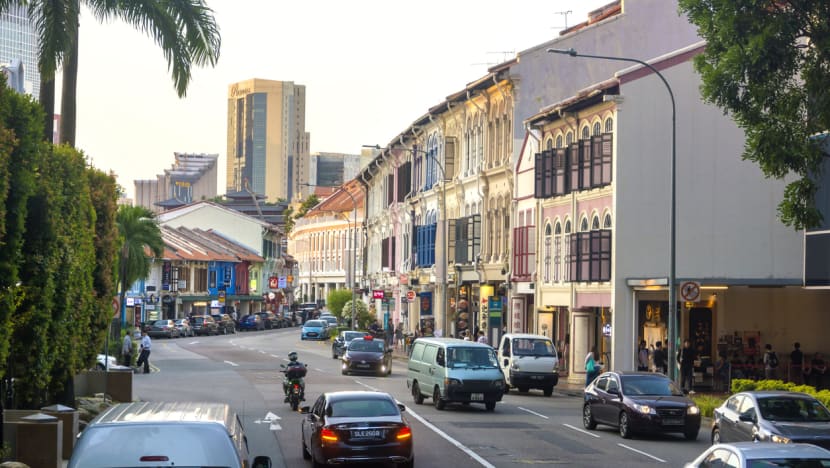How the COE system went from managing rapid vehicle growth to hitting record premiums
Why was the COE system conceived? And why does it seem to constantly evoke criticism today? CNA revisits the system's beginnings.

Vehicles along a street in Singapore. (File photo: iStock/DanielFerryanto)
SINGAPORE: Those looking to buy a car recently may have found themselves in a jam.
From August, bidding for a Certificate of Entitlement (COE) – which gives a person the right to own and use a vehicle in Singapore – will be based on a rolling average of vehicle deregistrations over two quarters instead of one.
This means the COEs available for August to October will be 11.5 per cent less than the previous three months.
The new counting method comes on the back of a surge in COE premiums in recent months. Prices in the Open Category, which can be used for any vehicle type but is used mainly for large cars, hit an all-time high of S$114,001 in July. This fell slightly to S$113,000 in the first August bidding exercise on Wednesday (Aug 3), but many car buyers remain worried about escalating COE prices.
But this isn’t the first time the COE system has been a talking point. CNA looks back at how the system has evolved since its inception.
CONTROLLING "RAPID GROWTH" OF VEHICLES
With its limited space, Singapore had to control the “rapid growth” in the number of vehicles in relation to road capacity as the nation grew in affluence, said LTA.
Between 1975 and 1990, for instance, car population grew by as high as 12 per cent per year before a recession in 1985.
Together with Electronic Road Pricing (ERP), the Vehicle Quota System became one of the key pillars of the country's traffic management strategies, states LTA’s OneMotoring website.
Introduced in 1990, the Vehicle Quota System was a “landmark scheme” implemented to cap the number of new vehicles that can be registered in Singapore and regulate the growth of the vehicle population. It was the key proposal of the Parliamentary Select Committee on Land Transport, which released its report on Jan 3, 1990.
COEs, an integral part of the Vehicle Quota System, were introduced in 1990 too.
In Singapore, a COE represents the right to vehicle ownership for a period of 10 years. Public buses, school buses and emergency vehicles are exempted from the COE scheme.
COE GROUNDED IN “SOCIAL EQUITY REASONS”
The first COE bidding exercise was held on Apr 2, 1990.
There were five categories of COEs available then: Two for passenger cars, one for motorcycles, one for commercial vehicles and an open category that can be used to buy any vehicle.
There is some segmentation in the number of categories for “social equity reasons”, noted a report from the Vehicle Quota System Review Committee under the then Ministry of Communications.
Nonetheless, under this system, each motorist or motor dealer who wants to own a car or other vehicle must bid for a COE in that category of vehicle.
The annual COE quota would be set at the projected number of vehicles deregistered the previous year, with the addition of new COEs based on a 3 per cent growth in the vehicle population, stated the committee's report.
The number of COEs released every fortnight is fixed before the start of the quota year. Adjustments to the supply are made if necessary.
From its beginnings, fairness appeared to be a cornerstone in the COE system. To ensure existing car owners did not have an unfair advantage, the Government decided that all vehicles would have an entitlement of 10 years from the date of registration.
This entitlement can be “revalidated” for another five or 10 years by paying for the prevailing quota premium, should the car owner decide to keep their car for more than 10 years, said author Winston Lee in his book, Quota System and the ARF/PARF Scheme.
But this vehicle entitlement can be transferred with the ownership of the vehicle.
The Vehicle Quota System’s central outcome was to cap the growth rate of the vehicle population at 3 per cent a year.
Without the Vehicle Quota System, the growth rate would have “spiralled” and traffic would have “ground to a halt, adversely affecting Singapore’s economic development and quality of life”, the Vehicle Quota System Review Committee said.
REVIEWING THE COE, VEHICLE QUOTA SYSTEM
Eight years after its inception, the Vehicle Quota System was set to be reviewed by a Government Parliamentary Committee in 1998.
The committee presented its findings in a report in March 1999.
These findings affirmed the effectiveness of the Vehicle Quota System as “one of the key pillars in Singapore’s traffic management strategies” and recommended that the scheme be retained.
They also concluded that competitive bidding was “the most efficient and equitable means of allocation of quota”, noted the Ministry of Communications.
CONTROVERSIES
Today, however, criticisms of the COE system seem to overshadow its initial intentions.
Many people have lamented, sometimes tongue-in-cheek, that the piece of paper to own a car often costs more than the vehicle itself.
But while the COE system is “certainly one of the more controversial” policies that the Government uses to manage transport in Singapore, it has to be judged on whether it contributes to a more sustainable and efficient transport system and not whether it makes motorists happy, said transport analyst Walter Theseira.
The associate professor from the School of Business at the Singapore University of Social Sciences said “the continued existence of high COE prices and excess demand for cars suggests that, for a variety of reasons, public transport does not yet meet everyone's needs sufficiently to reduce demand for car ownership to a low level”.
“So the most important thing to do is not to tweak the COE system, but to keep on improving public transport and urban planning to reduce the need to travel. So that demand falls for car ownership in the first instance,” he said.
Assoc Prof Theseira also suggested the COE system was never designed to address some fundamental issues in transport.
For instance, it was designed to efficiently allocate the right to own a vehicle, according to who is willing to pay the most for a vehicle, he said.
“But it’s not designed to answer the questions: How many vehicles should exist in the first place? And what is the mix of vehicles that suits Singapore's needs the best?”
Assoc Prof Theseira added that while authorities have tried answering the latter question with adjustments, these “have sometimes created unintended consequences”.
“The Open Category was meant to use market forces to gradually change the vehicle mix over time. Yet, this category soon became exclusively a ‘large car category’, because those were the buyers with the most ability to pay, resulting in greater growth for large cars,” he said.
Another unintended consequence stemmed from policies that “relaxed the growth rate of the private car population in the late 2000s”, said Assoc Prof Theseira.
“There were a variety of policy factors behind this, including the shift to ERP, which was marketed to the motoring population as a possible way of allowing expanded car ownership by moving motoring charges to usage rather than purchase.”
There were also changes to the way that quota from deregistered cars was predicted, and policymakers may have wanted to “accommodate the rapid growth of the economy and population then”.
“Regardless, the end result was that private car growth was on the order of 5 per cent per annum in the late 2000s – and was suddenly cut down by policy in the early 2010s. This resulted in a large bulge of COE issuances for private cars in the late 2000s, which is still affecting the COE system today,” said Assoc Prof Theseira.
“From the viewpoint of ideal transport policy, it's hard to believe that this is optimal.”
Assoc Prof Theseira reiterated that even though the use of policy to differentiate COEs between mass-market cars and luxury cars might be imperfect, the point is that the COE system is “creaking in many ways because of issues that it was never designed to solve”.
“It simply solves the allocation problem. Once you have decided how many vehicles should exist, it allocates them to buyers efficiently – although that aspect, of how bidding works and interacts with the market, is also poorly understood,” he said.
“Unfortunately, all the other problems, such as questions of how to make the system fairer, how to accommodate the different needs of industry, families, motorists and motorcyclists, can't be answered with the basic framework of the COE system.
“That requires policymakers to make judgments about how many vehicles should exist and why, which is much more complicated than simply auctioning them off to the highest bidder.”



















